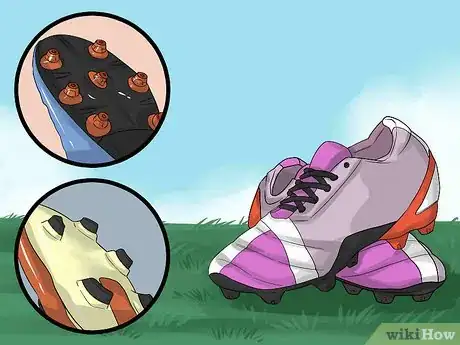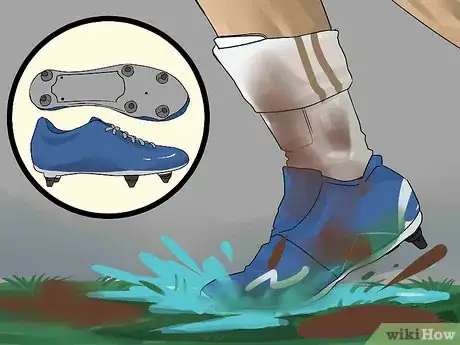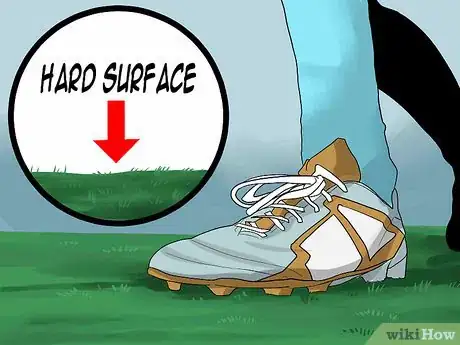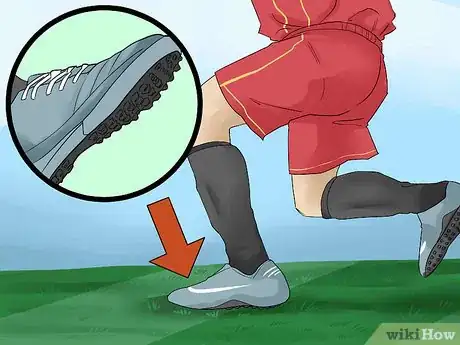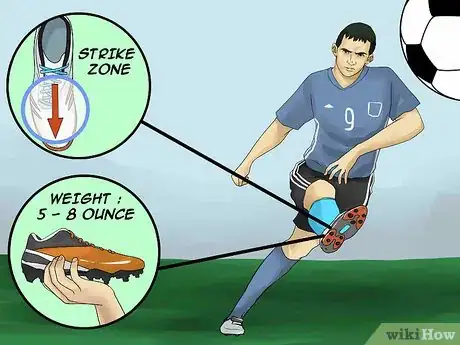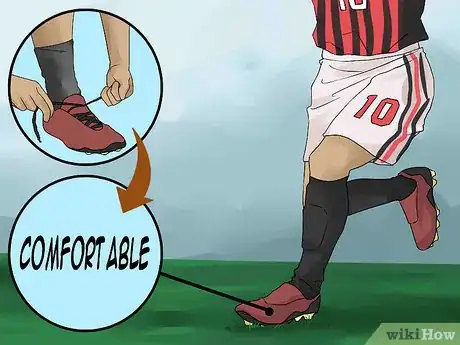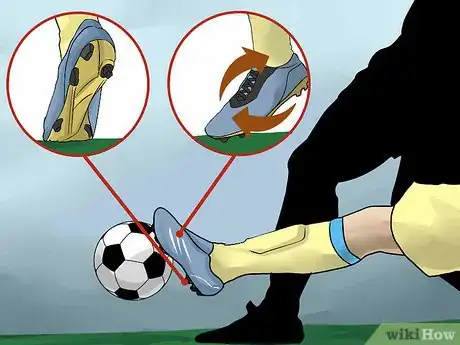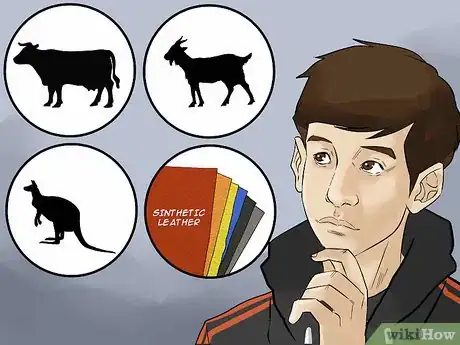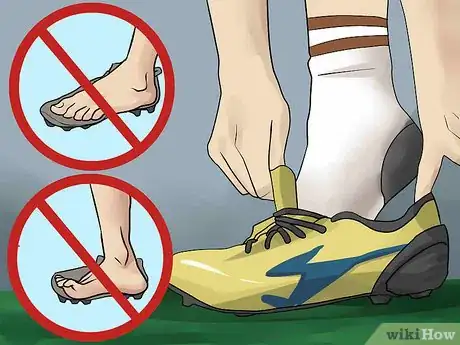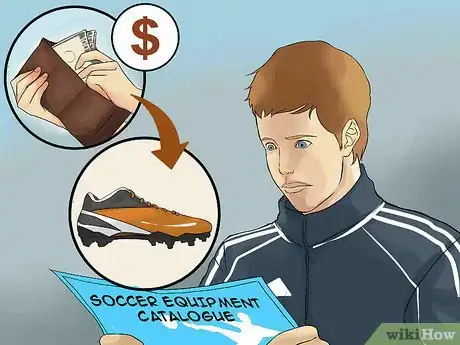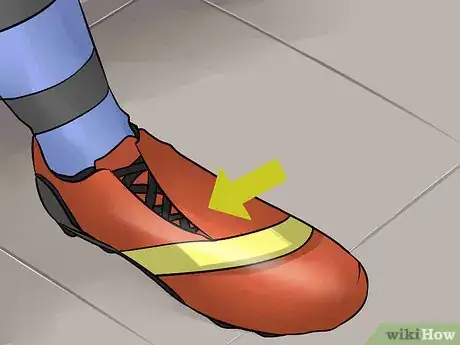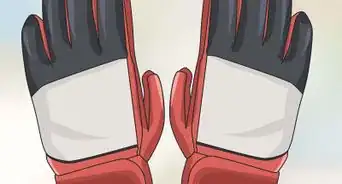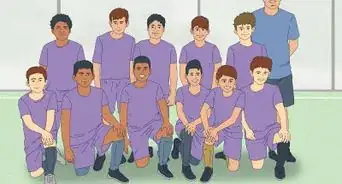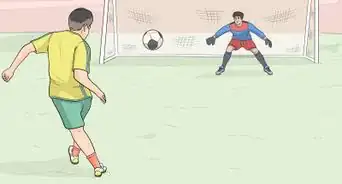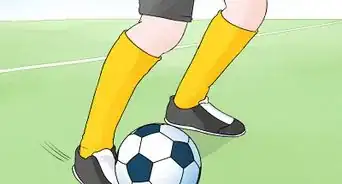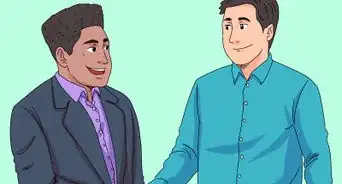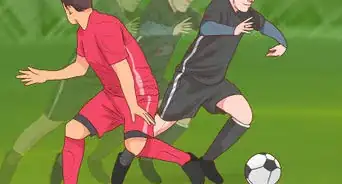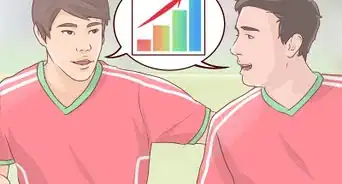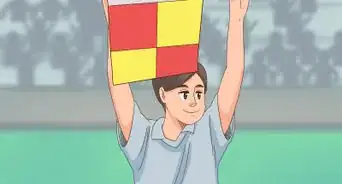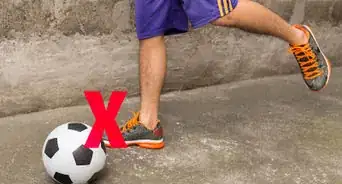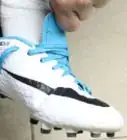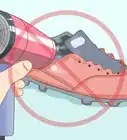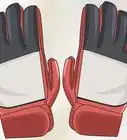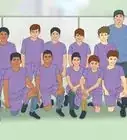This article was co-authored by wikiHow Staff. Our trained team of editors and researchers validate articles for accuracy and comprehensiveness. wikiHow's Content Management Team carefully monitors the work from our editorial staff to ensure that each article is backed by trusted research and meets our high quality standards.
This article has been viewed 70,745 times.
Learn more...
Choosing the right soccer cleats can be confusing. There’s so many different types of shoes available and they’re all designed specifically for certain types of players and conditions. While a particular soccer cleat may be perfect in certain circumstances, it can be useless or even dangerous to wear in the wrong ones. If you want to get the right cleats to help you perform at your peak, you’ll have to know exactly what to look for.
Steps
Choosing the Right Stud Pattern for the Pitch
-
1Play on firm surfaces. If you’ll be playing on a natural grass pitch where it doesn’t rain too regularly, you should use a pair of firm ground shoes. Firm ground shoes usually have ten or more long studs that are distributed evenly throughout the bottom rim of the shoe. They provide a sufficient amount of traction for normal playing conditions. The studs can either be conical or blade shaped.
- Conical studs are rounded at the bottom. They allow a player to have flexibility of motion.
- Blade shaped studs become thinner at the bottom of the shoe. They’re designed to dig into the pitch and give a player better traction. However, they don’t offer quite as much flexibility as conical studs because it’s harder to remove them from the ground.[1]
- Firm ground shoes are the safest shoes to buy if you don’t know what type of field you’ll be playing on. They’re considered acceptable for many different playing conditions.
-
2Be prepared for soft surfaces. If you’ll be playing on a pitch where it rains often you’ll need to wear a pair of soft ground cleats. The studs on a soft ground cleat are similar to those on a firm ground cleat. However, there is usually only about six of them and they are strategically placed so the shoe can offer maximum traction.
- The studs on a soft ground cleats can also be conical or blade shaped.
- On soft ground shoes, there will be two blades in the back of the shoe on either side of the heel and four blades positioned on the front of the shoe (two on either side about an inch from each other) to maintain balance.
- Soft ground shoes should only be used on soft surfaces. Wearing them in other conditions can lead to injury.
Advertisement -
3Keep your footing on hard surfaces. Hard ground shoes are designed to give players traction and balance on surfaces where much of the grass has been worn down leaving only the rigid ground beneath it. The bottom of a hard ground cleats is covered in small, flat studs. Unlike those of firm ground and soft ground cleats, the studs on a hard ground cleat are spread out over the entire bottom of the shoe.
- Hard ground cleats are not designed to dig into the ground. Rather, they offer grip to help a player balance on a solid surface.
- Their names may sound similar, but hard ground shoes are not appropriate for firm ground pitches.
-
4Handle yourself on turf. Many soccer leagues are starting to play on turf. It’s easy and cheap to maintain and it stays the same in almost every kind of weather. If turf cleats have studs at all, they’ll be very tiny and spread out over the entire bottom of the shoe. Rather than studs, they may simply have a slightly elevated pattern on the bottom that allows them to offer traction on the turf.[2]
- Don’t wear turf cleats on any other surface than turf. They don’t have studs long or sharp enough to grip different surfaces.
Selecting Shoes for Your Position
-
1Strike the ball. If you’re a forward, your main concern on the pitch is to score goals. You’ll need a shoe with a clean strike zone so you can connect with the ball effectively. The strike zone of a soccer cleat is the part that ideally should make contact with the ball. The strike zone or vamp of the shoe is located on the upper front part of the shoe.[3]
- As a forward, you may also want to get lighter shoes so you can make explosive movements. Look for shoes that weigh anywhere from five to eight ounces.
-
2Get comfortable. If you're a midfielder, you’ll spend most of a match running up and down the field. You’ll need shoes that won’t irritate your feet after spending ninety minutes sprinting back and forth. Make sure you pick shoes with comfortable insoles and midsoles in them with plenty of support for your heels.[4]
- The insoles are the soft cushions inside of the shoes. Some soccer cleats have removable insoles.
- The midsoles are cushions that are built into the shoe.
-
3Play defense. If you have a defensive position, your shoes will take a lot of punishment. Get shoes with a tough outsole that can withstand the damage. You’ll need to be able to stop on a dime and change directions easily while tracking opposing forwards. Consider getting shoes with great traction.
- You might also want your shoes to have a large strike zone for clearing the ball effectively.
- The outsole is the bottom of the shoe that takes damage as you start and stop.
-
4Move laterally. If you’re a keeper, traction will be the most important part of your shoe. Find shoes that can handle your back and forth motion. You’ll need to be able to dig in your feet and jump from side to side easily. A sizable strike zone will also will also benefit your ability to perform kick-outs and back passes.
Selecting the Right Cleats for Your Feet
-
1Choose your favorite material. Soccer cleats can be made from a variety of different fabrics. High quality kangaroo leather cleats will mold to your feet after playing in them for a while and they are very durable. However, they are a bit heavier than shoes made from synthetic materials. On the other hand, shoes made using mesh are usually very light weight, but they’re not good for playing in wet conditions as they can allow water to seep into your socks. Try on shoes made from a few different materials before deciding which one you like.[5]
- Cleats made from calf or goat leather are less expensive than ones made from kangaroo leather and can give you a similar feel.
- Some companies are developing synthetic leather strains in response to animal activists. The benefit of artificial leather is that different qualities, like water resistance, can be added to the material.
-
2Check the fit of the shoe. You want your shoes to feel snug, but not too tight. There should be about the width of a baby’s finger between your toe and the front of your shoe. If you can feel your toes scraping against the front of the shoe, then they’re too small. If you can fit your entire thumb between your toes and the front, then the shoes are too big.
- If you have wide feet, you might have to do some searching for shoes that fit you comfortably. Different brands make shoes for different foot widths. For example: Nike designs very thin shoes while Adidas makes shoes that are a little wider.
- Wearing shoes that don’t fit you properly can be very painful in a soccer match and can give you blisters on your feet. Long term, they can even cause bunions to form.
-
3Get the best shoes for your budget. If you plan on playing soccer competitively, you should purchase shoes that are either top-tier or mid-tier as far as quality. The top-tier cleats are the ones that the pros wear. They’re designed to accommodate peak performance play. However, they’re not built to last as professional soccer players often get new shoes every few matches. Mid-tier shoes are cheaper, more durable and often offer performance that is close to that of top-tier shoes.[6]
- Top-tier shoes usually cost one hundred and fifty dollars or more.
- Mid-tier shoes range from eighty to one hundred and fifty dollars.
- Low-tier shoes cost from forty to eighty dollars and should only be worn if you’re playing soccer for fun.
- Be careful about buying shoes that are originally priced under forty dollars. The quality is often very poor and can increase your risk of injury.
-
4Decide on the right lace placement. Modern soccer cleats don’t always have their shoelaces in the center. Some cleats are being designed with their laces toward the outside of the shoe to create a larger strike zone. If you’re used to your laces being central, it can take some time to get used to having them on the side. The lace placement can alter the fit and feeling of the shoe.
- If you like your cleats to feel tight, you may want to stick with central laces. Side laced shoes can have a looser feel.
Expert Q&A
-
QuestionHow do I clean my soccer cleats?
 Walter MerinoWalter Merino is a Youth Soccer Coach and Co-Founder of Ole Soccer Club based out of the Los Angeles, California area. He has coached youth from the age of four to the high school and college levels. Walter has played collegiate soccer for Cal Poly Pomona and Los Angeles Mission College. His accomplishments include coaching Olé Soccer Club to win the 2017 Cal South State Cup Governors Boys 2007 Division title.
Walter MerinoWalter Merino is a Youth Soccer Coach and Co-Founder of Ole Soccer Club based out of the Los Angeles, California area. He has coached youth from the age of four to the high school and college levels. Walter has played collegiate soccer for Cal Poly Pomona and Los Angeles Mission College. His accomplishments include coaching Olé Soccer Club to win the 2017 Cal South State Cup Governors Boys 2007 Division title.
Soccer Coach To clean soccer cleats, you can add them to a laundry washer and then allow them to air dry. Do not dry the cleats in a dryer as the leather may shrink.
To clean soccer cleats, you can add them to a laundry washer and then allow them to air dry. Do not dry the cleats in a dryer as the leather may shrink. -
QuestionDo you need to have cleats and shin guards for tryouts?
 Community AnswerYes! Both are necessary. Having both will also show that you are serious about the sport and will increase your chances of making the team.
Community AnswerYes! Both are necessary. Having both will also show that you are serious about the sport and will increase your chances of making the team. -
QuestionI have wide feed and wear an 8.5. UMBRO has a pair that fits me well, but when I'm moving fast, the middle bows out like a rubber band with each step. Is that normal?
 Community AnswerYes, it is! If they're new cleats, it's perfectly normal! They should break in eventually, but if they don't and keep doing it after about a month, then they're too big.
Community AnswerYes, it is! If they're new cleats, it's perfectly normal! They should break in eventually, but if they don't and keep doing it after about a month, then they're too big.
Warnings
- If your cleats don’t feel comfortable after a few wears, get new ones. The money you spent on them isn’t worth damaging your feet long-term.⧼thumbs_response⧽
- Know the rules of your league. Some leagues don’t allow things like cleats with detachable studs.⧼thumbs_response⧽
References
- ↑ https://m.youtube.com/watch?v=Fi01TGMW0ko
- ↑ http://www.my-youth-soccer-guide.com/soccer-shoes.html
- ↑ http://www.streetdirectory.com/travel_guide/205585/soccer/selecting_soccer_cleats_nightmare_or_lack_of_knowledge.html
- ↑ https://www.soccer.com/guide/soccer-shoe-guide/
- ↑ http://4specialtysoccer.com/choosing-the-right-soccer-shoes-for-your-playing-conditions
- ↑ http://www.soccercleats101.com/2013/07/04/complete-guide-to-picking-the-right-pair-of-soccer-cleats/
